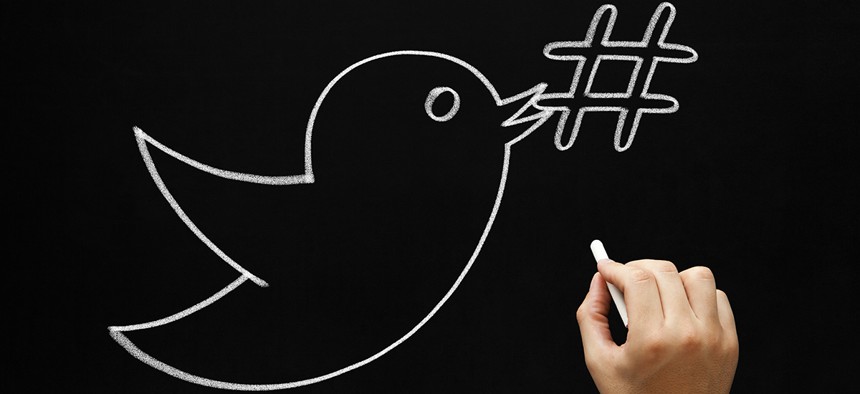
Ivelin Radkov/Shutterstock.com
These Presidential Candidates Are Making a Mark on Twitter
Having a lots of followers isn't enough.
That presidential candidate wouldn't want a mass Twitter following? For a group that thrives personally and professionally on public attention, the prospect of reaching hundreds of thousands without having to spend a dime (or say a word to reporters) is magic.
Of course, that assumes these Twitter users are actual people who are actually paying attention to the tweets filling their feeds. And in the Twitterverse, that's far from a guarantee.
After all, many Twitter users are inactive, "following" other users in the Twitter definition but not actually paying attention to them at all. For politicians hoping to use Twitter to spread their message, such accounts are of little use. Even worse for politicians are dummy accounts, those that are programmed to run automatically and have no human operating them.
And so, given that, from a candidate's perspective, not all Twitter users are created equal, figuring out which candidates are actually making their mark through Twitter requires a calculation more sophisticated than simply counting followers.
Fortunately, there's a different metric to measure the performance of campaigns on Twitter: engagement rate. Engagement rate moves past the question of how many followers a Twitter account has to analyze how often those followers interact with that account through actions such as retweeting, clicking on a link, or replying to the account.
"A pure vanity metric is how many followers you have," said John Randall, a vice president at digital consultancy firm CRAFT Media/Digital. "Just saying, 'I have X million of followers on Twitter'—there is a value to that. But the greater value is, 'I have X million number of followers and on any given post I have a large engagement rate.' "
Engagement on Twitter can be measured through several metrics. There are the most public-facing ones, like a follower retweeting or favoriting a particular tweet, which is displayed under every tweet on the platform; or the number of views a video gathers. Campaigns also look at the click-through rate of links they post to social media to see how many clicks (or donations) a particular tweet generates.
A high level of engagement for one tweet, however, isn't enough: "Trend over time is really important, not just a snapshot of one day or even one month," said Julia Smekalina, who heads political digital strategy at IMGE, a right-of-center digital-media consulting firm. "How is that engagement growing or sustaining?"
Getting the highest amount of favorites on Twitter is not the endgame for a campaign—there's no exchange rate between retweets and votes in the New Hampshire primary. Ultimately, the goal is to convert social-media interactions into something more tangible.
"In a sense, [social media] is a town square. It is you standing at your fence talking to your neighbor about a specific issue," said Randall. "It is that ability to make connections with voters and advocates to get them to donate, to share your message, and evangelize on your behalf.... Ultimately you can engage with them and hopefully turn a non-supporter into a supporter who will go out and vote for you on Election Day."
Despite the focus shifting from vanity numbers like follower count or number of tweets to more advanced metrics, campaigns still aren't looking at all of the engagement metrics. One area where most of the campaigns are lacking in engagement is replying directly to potential voters and supporters on Twitter.
"I was flying and we had a crazy three-hour delay, and you could immediately go on Twitter and follow complaints from people sitting on the plane with me to the airline, and the airline was responding back," Smekalina said. "How can campaigns replicate that? I don't know how well they're doing that yet."
But by the metrics the campaigns are focusing on, which 2016 candidates are really getting their message out on Twitter, and which ones are talking mostly to dead air? Here are their engagement scores, based on data from Tweetchup.com, a service that tracks several publicly accessible Twitter metrics, like the number of retweets, follower count, and tweets per day.
Average # of retweets (June 1-June 22)
Source: //tweetchup.com/
1. Ben Carson - 229.96
2. Rand Paul - 209.05
3. Ted Cruz* - 194.32
4. Marco Rubio - 179.56
5. Jeb Bush - 179.42
6. Rick Perry - 160.74
7. Donald Trump - 130.01
8. Scott Walker* - 68.19
9. Carly Fiorina - 47.45
10. Mike Huckabee - 43.54
11. Rick Santorum - 39.25
12. Bobby Jindal - 38.63
13. Lindsey Graham* - 20.72
14. John Kasich - 19.00
15. Chris Christie* - 15.47
16. George Pataki - 15.13
*Indicates two accounts
Average # of favorites (June 1 - June 22)
Source: //tweetchup.com/
1. Carson - 416.15
2. Paul - 292.194
3. Trump - 243.27
4. Perry - 194.55
5. Bush - 190.16
6. Cruz* – 165.90
7. Rubio - 160.5
8. Fiorina - 67.87
9 Walker* - 63.78
10. Huckabee - 61.88
11. Jindal - 49.94
12. Santorum -34.38
13. Kasich - 27.29
14. Graham* - 26.78
15. Christie* - 24.84
16. Pataki - 16.33
*Indicates two accounts
(Image via Ivelin Radkov/Shutterstock.com)






